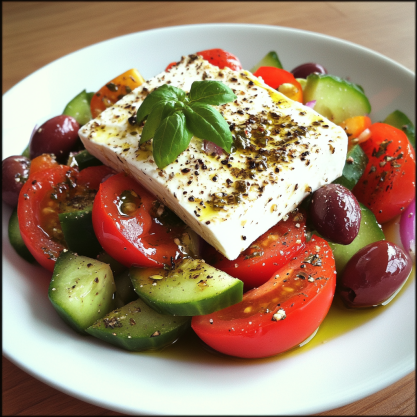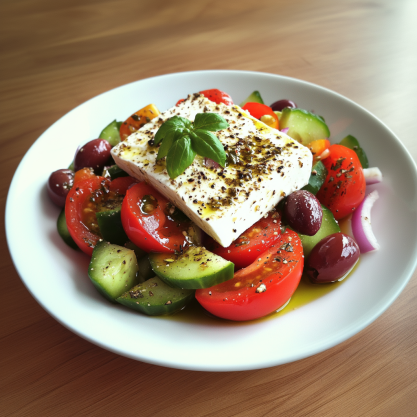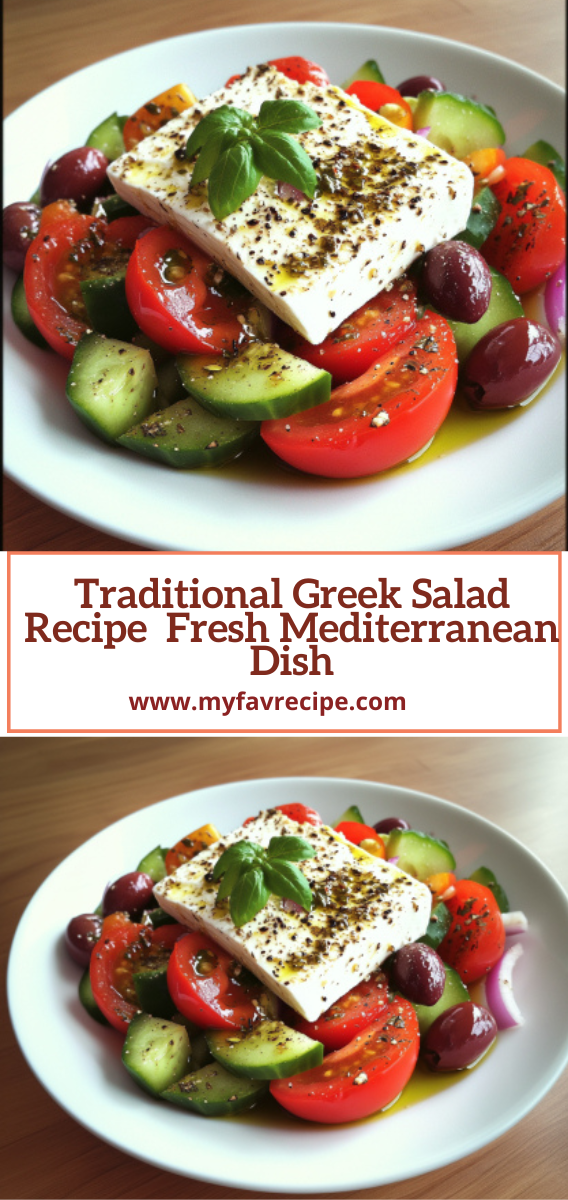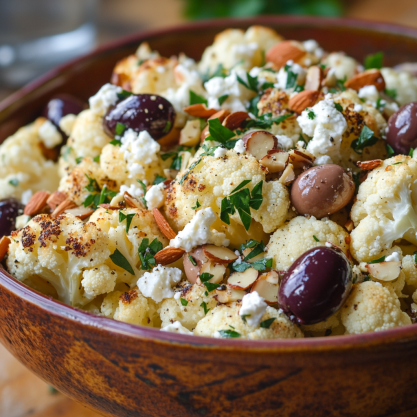Traditional Greek Salad Recipe Fresh Mediterranean Dish
Craving a taste of the Mediterranean? Look no further than the classic Greek salad recipe. This vibrant dish combines crisp vegetables, tangy feta, and zesty herbs. It’s a staple of the Mediterranean diet and a favorite healthy salad worldwide.

Greek salad is simple yet refreshing. Each bite offers a mix of textures and tastes that feel like a trip to sun-soaked islands. It’s perfect for a light lunch or a side dish at your next barbecue.
Ready to dive into this culinary treasure? Let’s explore the authentic Greek salad recipe that has won hearts and taste buds globally. Get ready to experience a burst of freshness that captures the essence of summer in every forkful.
The History and Heritage of Authentic Greek Salad
Greek salad is a key part of the Mediterranean diet, loved for its fresh taste and colors. It has a long history tied to Greek culture and food.
Mediterranean Roots
The Greek salad comes from Greece’s sunny lands. Farmers made it with their harvests. Tomatoes, cucumbers, and olives grew well there, making up the salad’s base.
It’s a big part of the Mediterranean diet, showing the area’s love for fresh, plant-based foods.
Greek Dining Traditions
In Greek homes, “horiatiki” salad is more than food. It’s a sign of welcome and shared meals. People come together, enjoying the salad and each other’s company.
Horiatiki’s Evolution
Over time, horiatiki has changed but stayed true to its roots. Today’s versions might add bell peppers or capers. But its core remains the same.
It’s now a favorite salad around the world, loved for its simplicity and health benefits.
As more people choose vegetarian meals, Greek salad is a top pick. It’s a mix of great tastes and textures. Its rise from a simple dish to a global favorite shows its lasting appeal.
Essential Ingredients for Perfect Greek Salad Recipe
A great Greek salad starts with top-notch ingredients. Let’s explore the key components that make this dish a Mediterranean masterpiece.
Fresh Vegetable Selection Guide
The heart of a Greek salad lies in its crisp vegetables. Choose firm, ripe tomatoes with vibrant color. Pick cucumbers that are dark green and free from blemishes. For red onions, select ones that are firm and have a deep purple hue.
Choosing the Right Feta Cheese
Feta cheese is the star of Greek salad. Opt for authentic Greek feta made from sheep’s milk or a blend of sheep and goat’s milk. It should be creamy yet crumbly with a tangy flavor.
Kalamata Olives and Their Importance
Kalamata olives add a rich, salty kick to the salad. Look for plump, dark purple olives with a smooth texture. Their distinct flavor complements the other ingredients perfectly.
Traditional Herbs and Seasonings
Enhance your salad with dried oregano, a sprinkle of salt, and a generous drizzle of extra virgin olive oil. These simple seasonings bring out the natural flavors of the vegetables, cheese, and olives.
- Tomatoes: Ripe and juicy
- Cucumber: Crisp and seedless
- Red onion: Thinly sliced
- Feta cheese: Creamy and tangy
- Olives: Kalamata variety
“The secret to a perfect Greek salad is in the quality of its ingredients. Fresh vegetables, authentic feta, and flavorful olives make all the difference.”
Step-by-Step Preparation Method
Creating the perfect Greek salad recipe starts with proper preparation. Begin by washing and drying all vegetables thoroughly. Slice crisp cucumbers into thick half-moons and quarter ripe tomatoes. Thinly slice red onions for a milder flavor.
Next, cube high-quality feta cheese into generous chunks. Pit and halve Kalamata olives. For optimal taste, use a ratio of 2 parts vegetables to 1 part cheese and olives.
To make the vinaigrette dressing:
- Combine extra virgin olive oil and red wine vinegar in a 3:1 ratio
- Add minced garlic, dried oregano, and a pinch of salt
- Whisk ingredients until well blended
Gently toss the vegetables, cheese, and olives in a large bowl. Drizzle the vinaigrette dressing over the salad just before serving. This ensures the vegetables stay crisp and the flavors remain fresh.
Tip: For an authentic touch, serve your Greek salad in a shallow bowl and top with a sprinkle of dried oregano.
Remember, the key to a delicious Greek salad lies in using the freshest ingredients and allowing their natural flavors to shine through. Enjoy your homemade Mediterranean delight!
Recipe card
Ready to make a delicious Greek salad? This recipe card has everything you need. Follow these simple steps for a refreshing and nutritious meal.
Equipment
- Large mixing bowl
- Cutting board
- Sharp knife
- Serving platter

Ingredients
- 4 ripe tomatoes, cut into wedges
- 1 cucumber, sliced
- 1 red onion, thinly sliced
- 1 green bell pepper, chopped
- 1 cup Kalamata olives
- 200g feta cheese, cubed
- 2 tablespoons extra virgin olive oil
- 1 teaspoon dried oregano
- Salt and pepper to taste
Instructions
- Wash and prepare all vegetables
- Combine tomatoes, cucumber, onion, and bell pepper in a large bowl
- Add Kalamata olives and feta cheese
- Drizzle with olive oil and sprinkle oregano
- Season with salt and pepper
- Gently toss all ingredients
- Transfer to a serving platter
- Serve immediately and enjoy your Greek salad recipe!
This Greek salad recipe serves 4 people. For a larger group, just double the ingredients. Adjust the feta or olives to your liking. Remember, fresh ingredients are essential for a perfect Greek salad and a key part of the Mediterranean diet.
Tips for Serving and Presentation
Greek salad is a hit in healthy salads and vegetarian meals. Its bright colors and fresh tastes are a treat for everyone. Here are some tips to make your Greek salad even better.
Ideal Temperature
Best to serve Greek salad at room temperature. This lets the flavors really come out. Take it out of the fridge 15-20 minutes before you serve it.
Visual Appeal
Make it look great by layering the ingredients. Start with lettuce, then add colorful veggies. Add feta and olives on top. Just before serving, drizzle olive oil and sprinkle herbs.
Perfect Pairings
Greek salad goes well with grilled meats or fish. For vegetarian options, try it with:
- Warm pita bread
- Hummus or tzatziki
- Falafel
Make-Ahead Tips
Prepare ingredients separately and store them in airtight containers. Mix everything just before serving to keep veggies crisp. For the best taste, add dressing and cheese last.
Follow these tips, and your Greek salad will impress everyone. It’s a great choice for healthy salads, adding tasty veggies to your meals.
Conclusion
The Greek salad recipe is a perfect example of the Mediterranean diet’s simplicity and taste. It mixes crisp veggies, tangy feta, and salty olives for a refreshing meal. By learning this recipe, you’re diving into a long-standing culinary tradition.
Adding Greek salad to your meals is a tasty way to eat more healthy salads. It’s full of vitamins, minerals, and good fats, great for your heart. You can also try different veggies or dressing amounts to make it your own.
For a real Greek salad, use fresh veggies and top-notch feta cheese. It’s a light, tasty meal option. Next time you want something refreshing, try this Greek salad recipe. It’s a delicious way to enjoy the Mediterranean diet’s health perks.
FAQ
What are the essential ingredients for an authentic Greek salad?
An authentic Greek salad needs ripe tomatoes, cucumber, and red onion. It also includes Kalamata olives, feta cheese, extra virgin olive oil, and dried oregano. Some people add green bell peppers and capers too.
Can I make Greek salad in advance?
You can prep some parts of Greek salad ahead. Chop the veggies and keep them in the fridge. But, add the dressing and feta just before serving for the best taste and texture.
Is Greek salad suitable for a vegetarian diet?
Yes, Greek salad is great for vegetarians. It’s full of fresh veggies and has feta cheese for protein, making it a good choice for a Mediterranean diet.
What’s the best way to cut vegetables for Greek salad?
Cut tomatoes into wedges, cucumber into thick half-moons, and red onion into thin slices. This way, each bite has a nice mix of flavors and textures.
Can I substitute ingredients in Greek salad?
You can swap some ingredients for a different taste. Try black olives instead of Kalamata or goat cheese for feta. But, these changes will change the salad’s classic taste.
What’s the best dressing for Greek salad?
A simple vinaigrette is the best dressing. Mix extra virgin olive oil, red wine vinegar, dried oregano, and a bit of salt. It brings out the salad’s fresh flavors without being too strong.
How long does Greek salad last in the refrigerator?
Dressed Greek salad is best eaten within 24 hours. Undressed salad parts can last 3-4 days in the fridge. Always check if they’re still fresh before eating.
Is Greek salad a healthy option?
Yes, Greek salad is healthy. It’s low in calories but rich in vitamins and minerals. It also has healthy fats from olive oil and feta cheese. It’s a key part of the Mediterranean diet, known for its health benefits.

Greek salad recipe
Ingredients
Equipment
Method
- Wash and prepare all vegetables
- Combine tomatoes, cucumber, onion, and bell pepper in a large bowl
- Add Kalamata olives and feta cheese
- Drizzle with olive oil and sprinkle oregano
- Season with salt and pepper
- Gently toss all ingredients
- Transfer to a serving platter
- Serve immediately and enjoy your Greek salad recipe!







